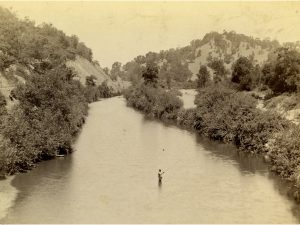 by Sarah Nathe
by Sarah Nathe
It is generally accepted that reunions are about people. You take a trip back to a place where you once lived in order to spend a couple of days with people you haven’t seen for awhile: family members, classmates, teammates, military buddies, work colleagues, summer camp friends. You spend most of the time “catching up” and reminiscing about the great times you had together whenever. That is certainly the focus of the new exhibit at the Kelley House Museum, “Kin and Kinship: Coming Home to Mendocino” that starts tomorrow and runs through November 13.
As I looked over the exhibit photos of local reunions past, I got to thinking about my own reunions and I realized that when I return to my hometown in northern Minnesota — another place that gets lots of mileage out of Paul Bunyan lore — seeing people is only part of my motivation. I go back to spend time walking in the woods, swimming in the lake, or paddling a canoe up the river. I go back to see and hear and smell and taste the North woods. I expect it is like that for many Mendocino natives when they come home.
You expect people to mature with age — go bald, turn gray, gain a little weight. Similarly, you can’t help noticing some differences in your old neighborhood, the downtown, or on the college campus. Even in historic Mendocino there are slight alterations. That’s what happens . . . towns and cities transform just like people . . . you can’t stop “progress.” However, when it comes to the natural world, to a particular landscape in our experience, even subtle shifts are troubling.
Thomas Wolfe, the man who gave us You Can’t Go Home Again, knew that time’s effects on people and places can’t be reversed, but he did think the cycles of nature were invariable. In a lyrical passage near the end of his novel, he writes:
Some things will never change. Lean down your ear upon the earth and listen. The voice of forest water in the night, the cricketing stitch of midday in hot meadows, the delicate web of children’s voices in bright air — these things will never change.
The glitter of sunlight on roughened water, the glory of the stars, the innocence of morning, the smell of the sea in harbors, the feathery blur and smoky buddings of young boughs, the thorn of spring, the sharp and tongueless cry — these things will always be the same.
All things belonging to the earth will never change — the leaf, the blade, the flower, the wind that cries and sleeps and wakes again, the trees whose stiff arms clash and tremble in the dark — all things proceeding from the earth to seasons, all things that lapse and change and come again upon the earth — these things will always be the same.
In this era of climate change, habitat degradation, and species extinction, we could only wish that he had been right. He knew you can’t step in the same river twice, but he thought the river would always be flowing. So, after you visit the Kelley House Museum exhibit, go out and play in the river while you can.